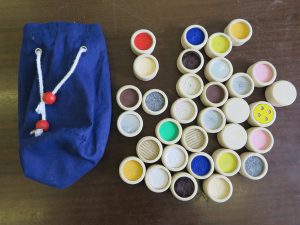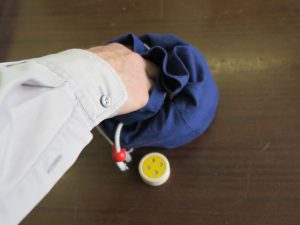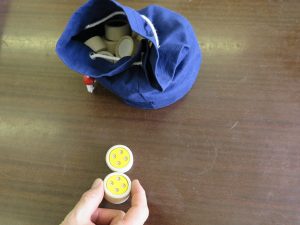
Play TACTILE DISCS if you want to explore the world of tactile and visual stimuli! To train your memory, perception and attention, try finding as many pairs of discs just by touch. Tactile discs are made of different materials and textures. The objective of the game is to find pairs of discs with the same texture or pattern, by touching and stroking the discs. Playing the game can also be an opportunity to awake pleasant memories and feelings associated to different materials. Compete with your friends and family and collect as many pairs as possible!
Basic information
Definition:
Tactile discs are discs, platforms or pegs made of different materials and of different patterns. They promote tactile discrimination and sensory integration, by touching, reconizing and becoming aware of different sensations and textures. Tactile discs provide tactile and visual sensory stimulation and promote motoric function and perception.
Objectives
The objective of the game is to find pairs of discs with the same texture or pattern, by touching and stroking the discs. The goal is to find as many pairs as possible. The game ends when all of the pairs are found.
This game can be very good to improve the following cognitive dimensions:
Duration
Duration depends on the number of players, number of pairs used and the player’s abilities (motoric function, motoric speed, visual perception, pattern recognition etc.). In a small group of up to 4 players the duration of the game is approximately 30 minutes.
Cost:
- Physical version: from 15€
References:
- Background material: download this pdf:
Explanation:
Development
Participants
Participants’ profile:
- Dementia level: mild to moderate dementia levels.
- Physical requirements:
- Generally low, but good ability to discriminate sensory stimuli (expecially tactile)
Number of participants:
- In pairs or small groups up to 4 participants.
Material and requirements
Materials needed to develop the game:
- In general:
- A table or other similar horizontal surface
- A chair or other comfortable surface to sit on
- Pairs of objects (discs, platforms, pegs, etc.) of different materials, textures, sizes, shapes, sounds, etc.
- A bag made of fabric, to put the objects inside
Environment considerations:
- Good lighting, low noise levels
Support needed
Professionals / relatives can:
- Explain the game instructions and their variants
- Supervise the correct playing of the game.
- Guide the player by clues, hints which pieces might go together
- Adapt the rules and objectives of the game in case of difficulties
Starting point:
- Put all of the objects in the bag and place the bag in the center of the table. The player takes or is given the bag when it’s their turn.
Development:
The rules for basic memory game apply. Adaptations and variations are possible, regarding the abilities of the players.
All of the pieces/ objects should be placed in a fabric bag. The bag should be placed on the table, in the center or in front of the player that starts the game.
Players take turns in trying to find pairs of matching objects. First, the player reaches in the bag, takes one object out (randomly) and places it in front. Then, the player reaches in the bag again and, only by touch, tries to find the pair (the object of the same texture, pattern). If the player is not successful, both objects are returned to the bag and the next player takes their turn. The game ends when all of the pairs are found. The player with the most pairs wins.
Additional information
Variants of the game:
- To simplify the game, only a few pairs of objects can be used.
- To make the game easier, objects can be arranged on the table in rows and columns (as in a classic memory game), the texture surface facing down. The players then pick up and turn the objects to see if they are a match. If not, the objects are put back and the other player takes their turn.
Alternative games:
Similar games:
Assessment:
- Pairs found by each player.
- Time needed to finish the game.
Notes / observations
- ICT version of this game is not available.
- Tactile discs are available for different sensory modalities, e. g. touch (fingers or toes), smell, sight, taste, sound, weight, etc..
Practical activity
In Tactile discs there are 16 pairs of wooden discs with different materials (32 discs altogether).
To prepare the game, put all of the discs in a bag and on the table.
The player who starts the game, puts one hand in the bag, selects one disc and puts it on the table in front of himself, facing upwards. The same player then put his hand in the bag again and tries to find a matching pair to the disc in front of him, using only touch. With the other hand, he can stroke the disc in front of him to find the correct texture and pattern.
If the player finds the correct pair of discs, he can continue searching for another pair. If the pair is not found, it is another player’s turn. He then follows the same procedure described above.
Players take turns until all of the pairs are found. The player who finds the most pairs is the winner.
![]()





